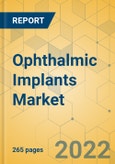Speak directly to the analyst to clarify any post sales queries you may have.
The ophthalmic implants market size is expected to grow at a CAGR of 6.5%.
MARKET GROWTH ENABLERS
- Growing Advancements in Ophthalmic Diagnostic Technology
- Increasing Adoption of Advanced Ocular Devices
- Increase in the Number of Cases Of Eye-Related Disorders
- Rise In Awareness of Diagnosis & Treatment of Eye Disorders
- Launches and approvals to Increase Market Share
- In May 2020, the launch of the presbyopia-correcting intraocular lens (IOL) LuxSmart and its monofocal version LuxGood was announced. Both have pre-loaded delivery systems and Pure Refractive Optics (PRO) technology.
- In January 2021, the AcrySof IQ Vivity IOL (Vivity), the non-diffractive intraocular lens with extended depth of field (IOL), was launched in the US. Vivity is used in the AcrySof IQ IOL.
GLOBAL OPHTHALMIC IMPLANTS MARKET SEGMENTATION ANALYSIS
The Intraocular Lenses are expected to witness the highest incremental growth and Glaucoma Implants are likely to witness the highest absolute growth during the forecast period. The rising cases of presbyopia, myopia, blindness, cataract surgery, and farsightedness are expected to drive demand for the global eye implant market. Other major reasons for the market's growth include increasing awareness of comprehensive eye care services, the surge in the geriatric population, and the inclusion of eye care services in the insurance system. The total number of patients undergoing cataract surgery has more than tripled in a decade, a key factor that has impacted players in the intraocular lens industry.
Hospitals are expected to witness the highest incremental growth during the forecast period. The Hospital segment is the dominant segment in the ophthalmic implant market. Glaucoma drainage implant surgery is performed in an outpatient surgery center or hospital.
Market Segmentation by Product
- Intraocular Lenses
- Glaucoma Implants
- Corneal Implants
- Others
Market Segmentation by Application
- CATARACT SURGERY
- GLAUCOMA SURGERY
- OTHERS
Market Segmentation by End-User
- Hospitals
- Ambulatory Surgery Centers
- Ophthalmic Clinics
VENDOR LANDSCAPE
Advances in ophthalmic diagnostic technology have resulted in wider product adoption. The easy accessibility of online tools has educated the public about various treatment options and will help the market grow. The increasing acceptance of advanced ocular devices such as artificial eyes and glaucoma devices has opened up the potential for companies active in the market. The increasing number of regulatory approvals for corneal implants devices will help large companies generate significant revenue in the eye implant market in the years to come. The emergence of various advanced intraocular lenses and increased competition between manufacturers to develop better lenses, as well as an increase in investment in eye research institutes by government and non-governmental organizations are expected to fuel market growth.
Key Vendors
- ALCON
- Johnson & Johnson
- Bausch & Lomb
Other Prominent Vendors
- Second Sight
- Micro Engineering Solutions
- Gulden Ophthalmic
- AJL Ophthalmic S.A
- EyeD Pharma
- Care Group
- F. Ad. Müller Söhne Gmbh & Co.KG
- Hoya Corporation
- MORCHER GmbH
- Ophtec BV
- BVI
- Rayner Intraocular Lenses Limited
- Glaukos Corporation
- CorNeat Vision
- HumanOptics
- Omni Lens
- IVANTIS
- InnFocus
- POLYACTIVA PTY LTD
- LAMBDAVISION
- SMR OPHTHALMIC PVT. LTD
- Labtician Ophthalmics, Inc
- Devine Meditech
- Innolens
- iSTAR Medical
GEOGRAPHIC OVERVIEW
The increasing ageing population and raising awareness in the North American region are expected to drive the ophthalmic implants market size in the region.
Market Segmentation by Region
- Europe
- Germany
- UK
- France
- Spain
- Italy
- North America
- US
- Canada
- APAC
- China
- India
- Japan
- South Korea
- Australia
- Latin America
- Mexico
- Argentina
- Brazil
- Middle East and Africa
- Turkey
- Saudi Arabia
- South Africa
THE REPORT INCLUDES:
1. The analysis of the global Ophthalmic Implants market provides market size and growth rate for the forecast period 2022-2027.
2. It offers comprehensive insights into current industry trends, trend forecast, and growth drivers about the global Ophthalmic Implants market.
3. The report provides the latest analysis of market share, growth drivers, challenges, and investment opportunities.
4. It offers a complete overview of market segments and the regional outlook of the Ophthalmic Implants market.
5. The report offers a detailed overview of the vendor landscape, competitive analysis, and critical market strategies to gain competitive advantage.
Table of Contents
Companies Mentioned
- ALCON
- Johnson & Johnson
- Bausch & Lomb
- Second Sight
- Micro Engineering Solutions
- Gulden Ophthalmic
- AJL Ophthalmic S.A
- EyeD Pharma
- Care Group
- F. Ad. Müller Söhne Gmbh & Co.KG
- Hoya Corporation
- MORCHER GmbH
- Ophtec BV
- BVI
- Rayner Intraocular Lenses Limited
- Glaukos Corporation
- CorNeat Vision
- HumanOptics
- Omni Lens
- IVANTIS
- InnFocus
- POLYACTIVA PTY LTD
- LAMBDAVISION
- SMR OPHTHALMIC PVT. LTD
- Labtician Ophthalmics, Inc
- Devine Meditech
- Innolens
- iSTAR Medical
Methodology
Our research comprises a mix of primary and secondary research. The secondary research sources that are typically referred to include, but are not limited to, company websites, annual reports, financial reports, company pipeline charts, broker reports, investor presentations and SEC filings, journals and conferences, internal proprietary databases, news articles, press releases, and webcasts specific to the companies operating in any given market.
Primary research involves email interactions with the industry participants across major geographies. The participants who typically take part in such a process include, but are not limited to, CEOs, VPs, business development managers, market intelligence managers, and national sales managers. We primarily rely on internal research work and internal databases that we have populated over the years. We cross-verify our secondary research findings with the primary respondents participating in the study.

LOADING...








